From Photographer to Naturalist
“Where is all this wild life you show so many pictures of and talk so much about?” is a question repeatedly asked us after an evening program at the Rim.
The answer, to a naturalist, is simple. Direct him to the habitat, and he knows the rest. To the layman, you must all too often begin as far back as the definition of the word “habitat”, and go on from there in an effort to condense in a verbal moment information which actually has taken years to compile into volume after volume of painstaking research, observation and experience, and which is still incomplete.
In the beginning, the amateur photographer of wild life is content to ask someone else for the answer to his questions. But inevitably the fascination of his pursuits make him want to find the answers for himself. It goes something like this:
One day going up a mountain trail that cut through a steep talus slope which ended in a lush green meadow a few yards below the trail, our novice caught a flash of movement among the boulders below him. Readying his camera, he watched and waited and was soon rewarded by the appearance of a strange little rabbit-like animal about six or eight inches long, dragging a sprig of Cascade aster through the rocks. The little creature paused just long enough for one click of the camera and disappeared.
The developed picture revealed that while the little animal was rabbit-like, there were significant differences. His ears were short and round. He seemed to have no tail at all, and our photographer recalled a peculiar high squeaking call which he could not associate with rabbits.
A naturalist friend glanced casually at the picture and remarked, “So you have been up in the talus slopes.”
Our friend was surprised. “How do you know that?”
“That’s where this fellow lives”, was the answer. “This is the cony, or pika, sometimes known as the little chief hare, the haymaker, or the ventriloquist of the talus slopes.”
“Do you mean,” he asked incredulously, “that you never find this cony or whatever you call him any place else?”
“Not precisely,” said the naturalist, “but that is where you are most likely to find him, because such terrain affords him the most of what he needs for existence – – the green grasses, sedges and flowering plant for the little hay stacks which he puts up under rock slides during the summer for his winter food supply, the quick shelter among the rocky crevices both from the weather and his natural enemies.”
“Well, then,” said the photographer, with a gleam in his eye, “if I want more pictures of the cony or the pika, all I have to do is find a rock slide and I can get all I want.”
“Not quite so simple as that. There must be food near the rock slide, and it must be at a certain altitude, usually from 5000 to 13,000 feet, depending on the section of the country he is in.” He turned to his library. “Look him up. You can find out all about him.”
He extended a book, but his friend laughed. “I’m not taking it as seriously as that. I know where to find him and that’s all I need to know.”
The naturalist smiled. “Well, I guess that settles Ochotona princeps.”
“What?” asked the photographer.
“His scientific name.”
The photographer laughed. “Oh,” he said, “That stuff is not for me.”
That evening the photographer showed his pictures to a group of friends, and when he came to his new little animal there was much excitement. He felt well prepared to answer any questions.
“What is it?” asked one. “It’s a – – – ” and he had to think a minute, but finally it came to him, “cony or pika” he said triumphantly.
Then someone said, “But what’s it’s scientific name?” This question came from a friend who was known as “The Scientist.”
“I don’t know,” he said. “I don’t care about scientific names.” And he went on quickly. “He lives in rock slides because that’s where his food is. I mean,” he said, as The Scientist raised his brows, “If the rock slide is close to a meadow, that’s where his food is, and also he can find protection from his natural enemies there.” He was beginning to sweat a little.
“Natural enemies?” inquired The Scientist. “What are his natural enemies?”
Our photographer was suddenly desperate.
“I haven’t looked that up yet,” he snapped, and suddenly he had brilliant flash of recollection.
“His scientific name,” he said “is Ochotona.”
“Oh, of course – – Ochotona,” said The Scientist, “but is it Ochotona princeps orOchotona shisticeps shisticeps or Ochotona brunnescens or Ochotona fumosa?”
The photographer wasn’t sure what happened after that.
Late that night he decided what he was going to do, and day-break found him headed for the home of his naturalist friend to borrow the book that told about the strange little animal that looked like a rabbit but wasn’t.
“That book,” he said, as casually as he could make it. “Could I–”
“Of course,” said the naturalist, and gave it to him at once. He hadn’t even put it back on the shelf. “While you are about it,” he added, smiling, “you will want to look up the golden-mantled ground squirrel, the yellow – bellied marmot, the pine marten and the red fox. There are many others but don’t try to take in too much at one time. ”
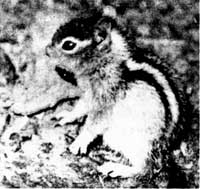 The ground squirrel . . . |
The photographer gulped.
“I’ve marked the pages,” the naturalist said soothingly. “You see, one thing follows another.
We must know their habits, you see. Where they live, and how and when. Some are out in the day time, some at night. Some live in trees, others on the ground. Some hibernate, others do not, some migrate, others–”
The photographer stood up with an air of sudden decision, and started out.
“Wait,” cried the naturalist, “you’re forgetting to take my book!”
The photographer turned and for the first time that day he was smiling.
“I’ve got a better idea,” he said, “I’m going to buy one for myself!”
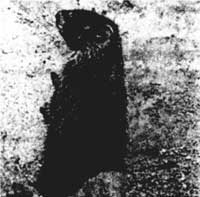 and the marmot . . . |
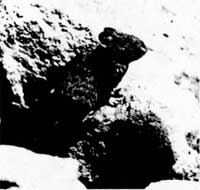 like the cony . . . |
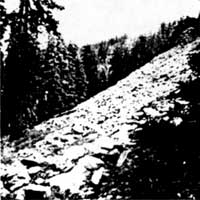 live where they do . . . |
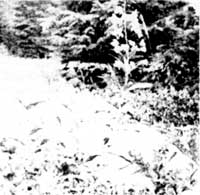 because of what grows there. They eat the vegetation . . . |
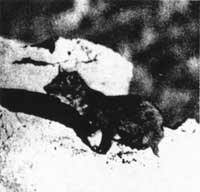 and the marten . . . |
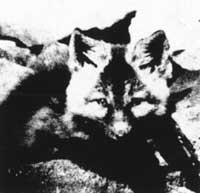 and the fox eat them. |

